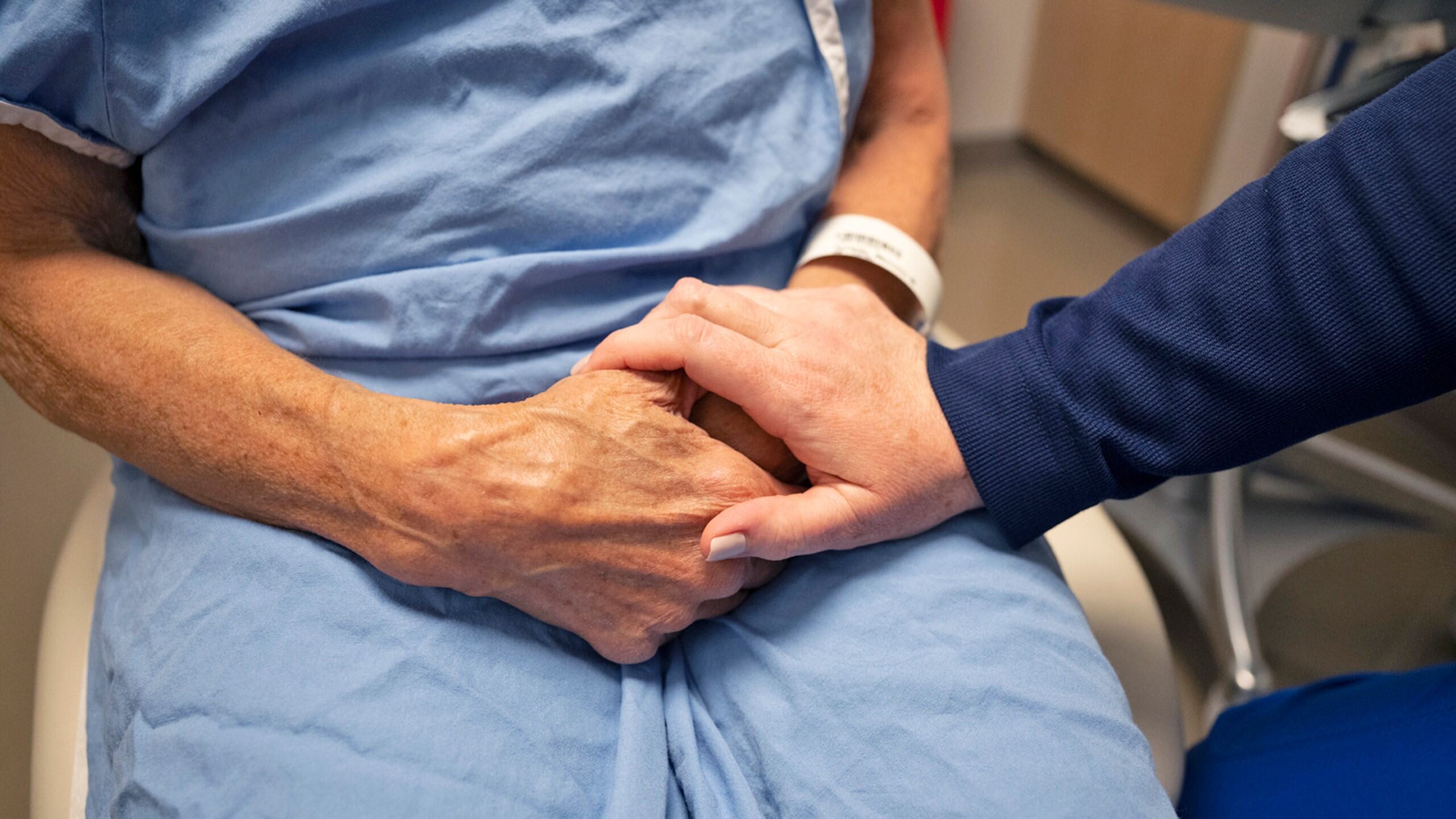Radiation Therapy for Breast Cancer

Overview
Surgery is part of breast cancer treatment for most people. Your doctor may also recommend radiation therapy.
Radiation therapy uses high-energy X-rays to kill cancer cells. MSK offers precise radiation therapy that kills breast cancer cells with fewer side effects from radiation. This keeps the healthy tissues and organs close to your breasts safe.
You may have radiation therapy on its own. Or, you may have it before, during, or after surgery or chemotherapy.
Your care team may suggest breast cancer radiation therapy after a lumpectomy or after a mastectomy.
To understand how radiation therapy fits into breast cancer treatment, this is a good place to start.
How is radiation therapy used to treat breast cancer?
Radiation therapy can be used in a few ways to treat people with breast cancer.
-
After a lumpectomy
-
After a mastectomy
-
For metastatic breast cancer
Types of radiation therapy
There are 2 main types of radiation therapy for breast cancer. They are external beam radiation therapy and brachytherapy (BRAY-kee-THAYR-uh-pee).
Doctors at MSK are national experts in both types. They’ll recommend which is best for you, based on the cancer and your preferences.
External beam radiation therapy
External beam radiation therapy is the most common type of radiation therapy for breast cancer.
This method uses a treatment machine to aim beams of radiation at the tumor. The beams pass through your body and damage cancer cells in their path. You will not see or feel the radiation.
The radiation is in the form of X-rays, protons, or other types of energy.
MSK Precise®
MSK Precise® can treat early-stage breast cancer after a lumpectomy. This method uses a precise, high-dose form of radiation therapy called stereotactic body radiotherapy (SBRT).
It delivers higher doses of radiation than standard therapy. You will have fewer treatments over a shorter period of time because the treatment doses are stronger.
You may have fewer skin reactions and side effects. MSK Precise also lets you get back to your daily life faster because of the shorter treatment schedule.
Intensity-modulated radiation therapy (IMRT) for breast cancer
Intensity-modulated means we can change the radiation beams’ power during your treatment. IMRT uses a special computer program to make a dose plan for radiation to the breast. This technology prevents hot spots, which are areas that get more radiation because of the shape of the breast.
IMRT also has fewer side effects. We sometimes use IMRT to limit the radiation dose to lymph nodes that need treatment. We also can limit radiation to organs close to the breast, such as the heart and lungs.
Image-guided radiation therapy (IGRT) for breast cancer
IGRT most often is used for breast cancer that has spread to other parts of the body.
Image-guided means we take images during IGRT to help guide the radiation beams. Imaging can include X-rays and CT scans to locate the tumor just before giving the radiation dose.
IGRT can treat tumors with even more accuracy than traditional radiation therapy. This method gives a very precise dose of radiation right to the tumor.
Stereotactic body radiation therapy is a very similar approach. It’s also used for metastatic breast cancer.
Proton therapy for breast cancer
Proton therapy is a treatment for lymph nodes or for people who already have had radiation.
Also called proton beam therapy, this type of radiation therapy uses charged particles called protons to kill cancer cells. A device called a cyclotron sends tiny, high-energy beams of protons to the tumor.
With proton therapy, the beams do not go past the tumor. It can cause fewer side effects because healthy tissue near the tumor is more likely to be safe.
MSK is one of the leading centers in the world to use proton therapy for breast cancer.
Brachytherapy (internal radiation)
Brachytherapy (BRAY-kee-THAYR-uh-pee), also called internal radiation, puts the radioactive material close to or inside the tumor. The radiation does not travel far from the radioactive material. The tumor gets a high radiation dose while nearby healthy tissue gets little or no radiation.
Brachytherapy in general is only used for partial-breast radiation after a lumpectomy. If the tumor was removed during surgery, we place the radiation where the tumor used to be.
We have long been a pioneer in developing and improving ways to kill tumors safely with radiation therapy. We use a method called MSK Precise®. It’s safe, works very well, and lowers the number of treatments you’ll need. You can get back faster to your life and what’s important to you.
Innovations at MSK
Our experts always are finding new ways to treat breast cancer and manage side effects. Explore breast cancer news from MSK.

Learn how people with early stage breast cancer can receive radiation therapy without the need for tattoos at Memorial Sloan Kettering Cancer Center.
Side effects of radiation therapy
What are the side effects of radiation therapy?
Radiation treatments are very precise and cause little harm to healthy tissues. This treatment does not cause hair loss. Many people report few lasting side effects.
In general, you can keep doing your daily activities, or keep working through treatment.
Some people do have symptoms after a few weeks, such as:
- Skin irritation.
- Fatigue (feeling very tired).
- Swelling and heaviness in the breast.
Our Integrative Medicine Service (also called complementary therapies) offers acupuncture, meditation, massage therapy, yoga, and exercise. Without using prescription drugs, integrative therapies can help improve and control side effects of cancer treatment.
What are late effects of radiation therapy?
Side effects can start months or years after treatment ends. These are called long-term or late effects. Late effects of breast cancer radiation are not common. They can include:
- Inflammation in the lung, most often with people who also had chemotherapy.
- Injury to the heart where there was a lot of exposure from radiation.
- Lymphedema in the arm, most often when radiation therapy starts after a lymph node dissection.
How do we limit exposure to radiation during treatment?
MSK’s radiation experts do everything possible to lower the chances of harming the heart and lungs. They use the most precise ways to deliver radiation to treat each type of breast cancer. These methods limit healthy tissue’s exposure to radiation.
Prone breast radiation therapy
For this method, you’ll lie on your stomach instead of on your back.
We aim radiation at the breast as it hangs through an opening in the treatment table. This method can lower radiation exposure to nearby organs, such as the heart and lungs.
Research shows that prone breast radiation reduces radiation burn on the skin. It also shows this method is very useful for treating large breasts.
Deep inspiration breath hold
This is a method to treat cancer in the left breast that lowers the risk to your heart.
Very experienced MSK radiation therapists guide you through a breathing method called deep inspiration breath hold (DIBH). We measure your lung capacity before DIBH to make sure this method is right for you.
You hold your breath to make the lungs push the heart away from the breast just before radiation. Our special computer program will shut off the radiation just when you stop holding your breath. The beam does not hit the heart if it moves into the radiation field.
Understanding Radiation to Treat Breast Cancer
Dr. Diane Reidy-Lagunes talks with radiation oncologist Dr. Michael Bernstein about radiation therapy and its side effects. Radiation is just an X-ray. Treatment can cause low energy, feeling very tired, and a skin reaction.

